14 Home Studios That Nurture Creativity and Art
One thing you’ll notice about the studios uploaded by the Houzz community is that no two are alike. Some are more than 1,000 square feet, while others don’t even approach 100. Some studios were built especially for this purpose, while others lived former lives as garages or porches or still double as the dining room. Regardless of how they look or what it took to build them, all of these spaces inspire, enlighten and allow their inhabitants to experience their most creative and best selves.
Here are 14 studios that readers and design pros uploaded. All of the uploaders shared something about the space that works for them, from having good speakers to creating a sense of seclusion, that we hope might help inspire you to make your creative space yours.
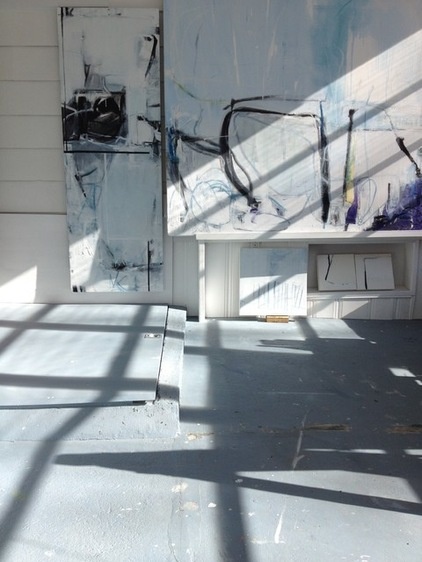
White and Light-Washed Painting Studio
Emilia Dubicki converted her home’s enclosed patio into a space in which to paint and make artwork. She removed the artificial turf flooring and Styrofoam drop ceilings and then painted the raw concrete floors and covered the now-taller ceiling with beadboard in cool colors reminiscent of her art, shown here. Two walls of windows provide plenty of natural light and bring views of her garden inside.
In addition to good natural light, Dubicki suggests that every studio have good task lighting, a work surface, good speakers for music, a floor you won’t worry about messing up with paint, and space for hanging up and looking at your work.
Size: 260 square feet
Location: Enclosed patio
What it’s used for: Painting and making other art pieces
Studio essential: Natural light and storage to keep the space free of clutter
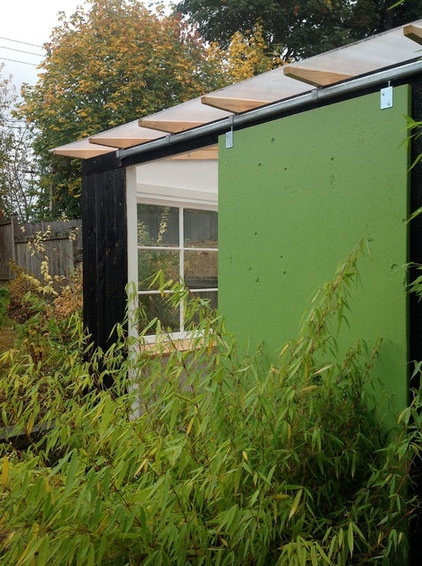
Studio of Seclusion
Architect Matt Hutchins of Cast Architecture built this painting studio–toolshed in his yard; it’s just big enough for a workbench, an easel and some storage. “At 7 feet by 11 feet, it isn’t big on purpose, so that I can’t be tempted to fill it up with junk and still be able to work,” Hutchins says. A large sliding door makes it easy to move things in and out.
He built the structure using shou-sugi-ban charred cedar siding and a translucent polycarbonate roof to take in the northern light. The interior framing is exposed, and the walls are painted plain white. “The purity and simplicity gives it a nice balance of repose, charm and focus,” he says.
Named Kalaloch, after a remote beach in Olympic National Park, Washington, the studio transports him out of the everyday. Hutchison was inspired by George Bernard Shaw, who named his writer’s cabin London, so that his staff could tell visitors that Shaw was in London.
Size: 77 square feet
Location: Across the terrace from the main house
What it’s used for: Painting; storing tools
Studio essential: Distance from daily life so that it feels remote and special
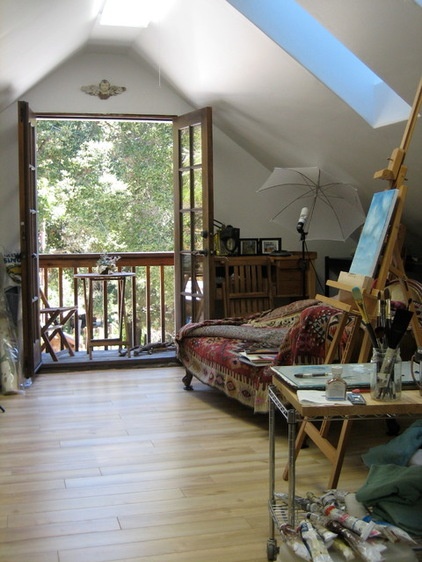
Light-Filled Attic
Lorrie Kempf and her husband converted their attic into a space where she could draw, paint and make jewelry. Built-in storage lines the A-frame walls, and a large, movable easel system allows her to take advantage of the room’s unusual shape.
With views of Big Sur, California, out her window, sounds of chirping birds and the scent of wild sage inundating her senses, it’s no wonder she finds this a creative place.
Size: 500 square feet
Location: Converted attic
What it’s used for: Oil painting and making large-scale charcoal drawings
Studio essential: Passion for what you’re doing. “I feel blessed to have my new space, but I’ve been productive and grateful for much less ideal spaces in the past,” she says.
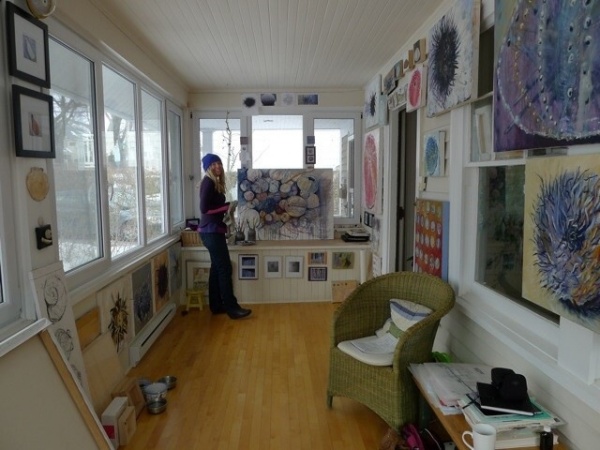
Front Porch Turned Painting Space
Elizabeth Jay installed new hardwood floors, insulation and windows to convert her home’s front porch into her painting studio. She built in a storage bench on one end, and a couch makes a nice reading spot. “I used to work as an architect in an office but created the home studio to be at home when my kids were young,” she says. Her walls are covered with her paintings to keep the floor as clear as possible.
Size: 182 square feet
Location: Converted enclosed porch
What it’s used for: Painting
Studio essential: Creating a space you want to spend time in. For Jay, natural light and being able to see the neighborhood go by make the difference.
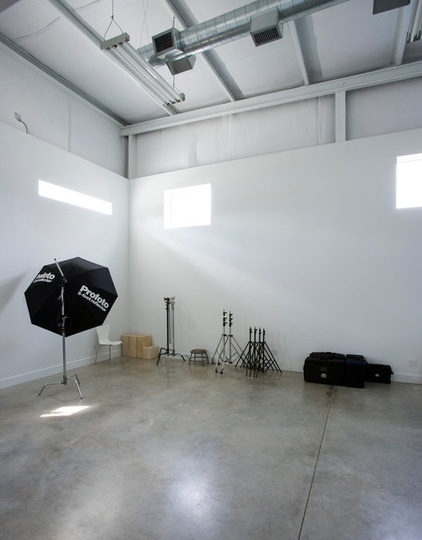
Modern Photography Studio
Professional photographer Felix Sanchez designed his photography studio as a big box with plenty of windows for natural light. He kept the shooting area here open with 22-foot-high ceilings. “Although I often use studio lighting to create my images, I have occasionally used the natural ambient light, and it creates a very soft and pleasing look,” Sanchez says.
Size: 700 square feet
Location: Custom-designed studio
What it’s used for: Photography
Studio essential: Having enough storage space to keep everything organized and the workspace open
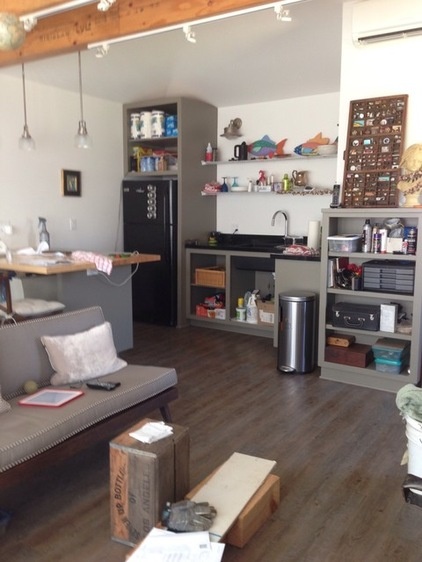
Studio Space With Room for a Little of Everything
After living in her house for more than 12 years, Bette Levine, a former commercial illustrator, converted her garage into an art studio, complete with a bathroom, a kitchen and built-in storage.
Levine uses her studio to make a lot of different things, so having her tools in one place, along with the things she collects for her projects, helps inspire her creativity. “Seeing my collection of birds’ nests or fishing lures and wondering what can I do with them is great,” Levine says. “I’ll have everything I need right there.”
Size: 350 square feet
Location: Converted garage
What it’s used for: Making things of all kinds
Studio essentials: Storage, flat surfaces, light, an outdoor connection and a lot of electrical outlets
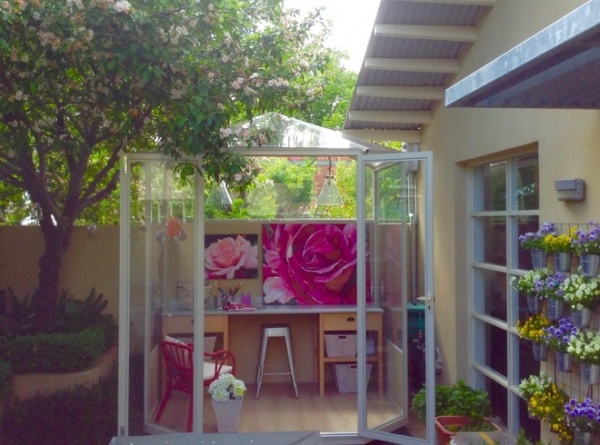
Studio in the Garden
Virginia Krafft paints and sometimes just relaxes in a compact studio her husband built for her next to their home in Williamstown, Victoria, Australia. “I love the fact that he has made it so light with the transparent construction, and find it very inspirational to be surrounded by our garden,” Krafft says. In the summer she opens up all the doors and paints.
Size: 48 square feet
Location: Polycarbonate structure in her home’s courtyard
What it’s used for: Making watercolor and acrylic floral paintings and still lifes
Studio essential: Being surrounded by natural light on all sides. It gives Krafft a sense of being in the garden when she paints.
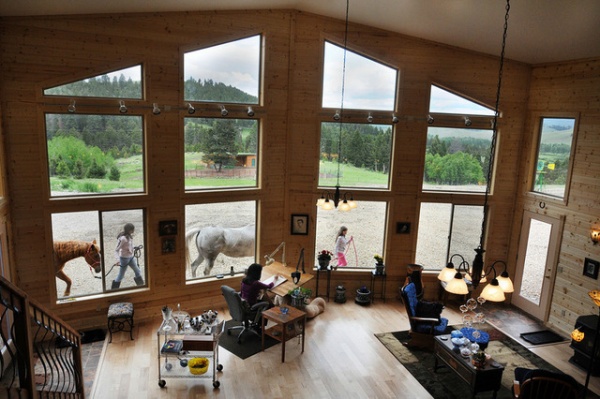
Window to Nature
Two years ago Nancy Quinn and her husband designed and helped build the studio shown here on their Montana property. Quinn has been a wildlife artist for 30 years and wanted a completely separate space in wihch to paint and run all aspects of her business. She and her husband bought many of the materials and finishes from resale shops and did most of the interior finishing themselves.
The incredible view of surrounding mountains and daily sunsets inspires Quinn while she works in the studio, and her rolling cart with paints, brushes and pencils makes cleanup simple.
Size: 1,200 square feet (with 23-foot vaulted ceilings)
Location: 40 feet from her house, overlooking the mountains
What it’s used for: All aspects of Quinn’s wildlife art business
Studio essential: Quinn surrounds herself with meaningful items to feel comfortable, including a self-portrait painted by her father.
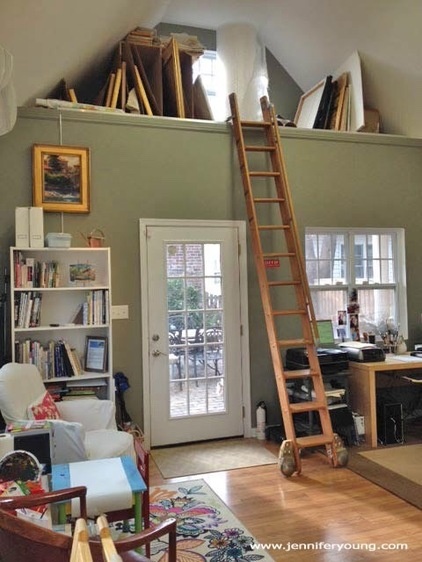
The Cathedral
Four years ago Jennifer Young built an art studio on her property in which to run her art business. She paints and sells oil landscapes. “Because of the nature of my medium, I really have to keep my workspace separate from my living space, or else the fumes would bother my family in our small home,” Young says.
There are many things Young likes about her studio, including the location and the large windows and French doors, but the high vaulted ceiling tops her list. “No matter what may be happening out there, when I enter my studio space, it is as if I am entering the church of art,” she says. The ceiling’s shape also disperses light in a way that avoids glare.
Size: 448 square feet
Location: One large, open space away from the house with different stations set up to handle different aspects of her art business
What it’s used for: Making oil landscape paintings and running a business
Studio essentials: A good combination of natural and artificial (full-spectrum) light, plenty of different storage types, good ventilation, a place to study art and a place for studying and reading
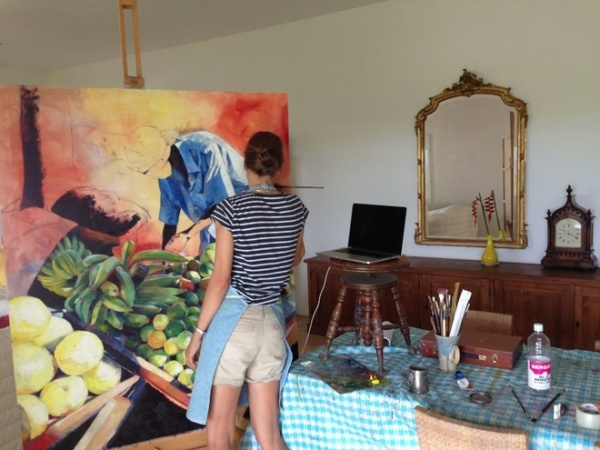
Next to the Dining Table
This studio might work the hardest, because when Kirsten Dear isn’t painting, it functions as her dining room. She covers the dining table with a plastic tablecloth when painting and stores all of her supplies in the teak sideboard seen here. She stores her paintings in a back room and puts her palette on a shelf in the freezer.
Size: Enough space to stand with an easel and a dining table
Location: The dining room
What it’s used for: Painting
Studio essentials: Good lighting, ventilation and music
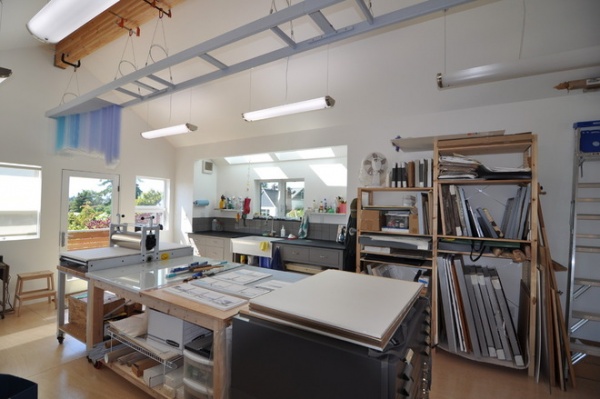
Energy-Efficient Studio for Two Artists
Goforth Gill Architects, along with Ventana Construction, designed and built a two-story studio in a backyard belonging to two artists. Plenty of storage, natural light and wall space help the space function, while artistic concrete work and exposed ceiling systems incorporate unique artistry.
Size: 800 square feet
Location: Separate studio in the backyard
What it’s used for: Work by two artists; each gets a floor
Studio essentials: Good ventilation and good light, both natural and artificial
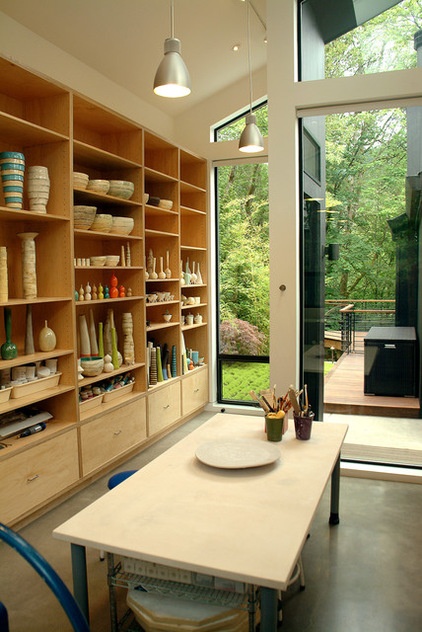
Ceramics Studio in the Trees
Giulietti Schouten Architectsbuilt this studio and guest suite for Portland, Oregon, ceramicistMarika van Adelsberg next to the home they renovated for van Adelsberg and her husband. Following the style of the house, the studio blends with the property while creating a destination in the landscape.
A wall of built-in maple shelves, a large workspace and concrete floors give van Adelsberg space to play without requiring her to be tidy.
Size: 260 square feet
Location: Multiuse studio that’s steps from the main house
What it’s used for: Making pottery. It can also be a gallery space or guest suite.
Studio essential: Enough room to get messy
See more of this Portland studio
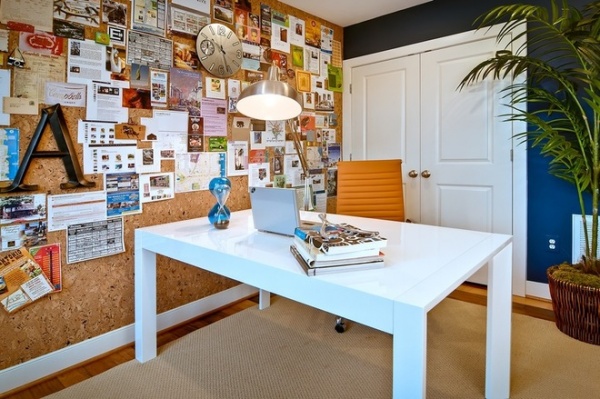
Functional Writer’s Retreat
A cork-covered wall and an oversize workspace helped transform an ordinary room into an inspiring writer’s retreat.
Carlyn And Company Interiors + Design arranged the desk so that the wall is easily accessible. While sitting at the desk, the writer can pin up inspiration or keep track of information, story patterns or other details for a current piece. Sitting at the desk, the writer looks directly out a window to the view beyond.
Location: First-floor room
What it’s used for: Writer’s studio
Studio essentials: Good lighting and a source of inspiration, in this case the ever-changing corkboard wall
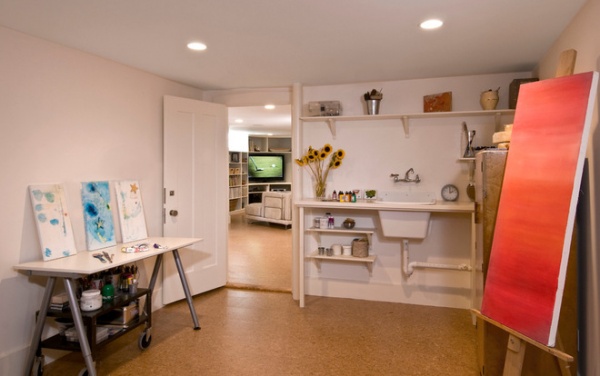
Painting Studio in a Family Basement
Landmark Services helped a young family of six take advantage of all the available space in their historic Greek revival home outside Boston. They insulated and finished the walls and ceilings, rerouted pipes and ductwork, and put down cork flooring in the formerly dark, damp basement. One area in the basement serves as a playroom and TV area for the entire family, and a dedicated art studio was created for the mother. Custom built-ins and a sink make the space even more functional.
“The bright walls and ceilings and the resilient cork floor provide a space that’s easy to work in,” says Mark Landry, of Landmark Services. With the studio at the end of the basement, the client can find solitude when painting, but she’s close enough to the rest of the house that it can be for brief periods of time.
Size: 286 square feet
Location: Basement corner
What it’s used for: Dedicated art studio
Studio essentials: Good ventilation, natural light, soft flooring and a sink
More: 11 Tips to Get the Creative Space You Crave












